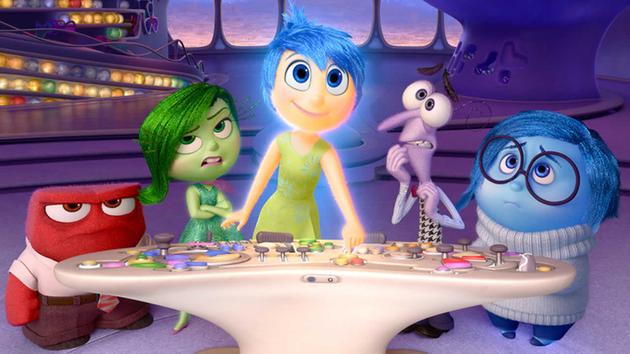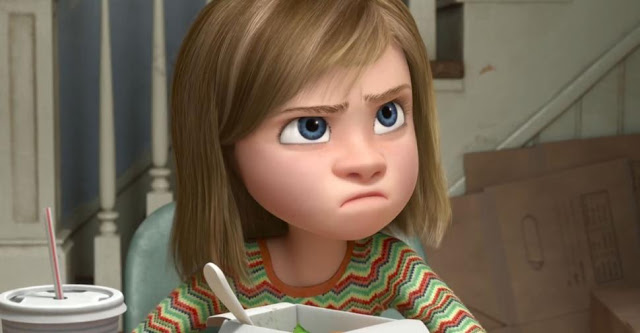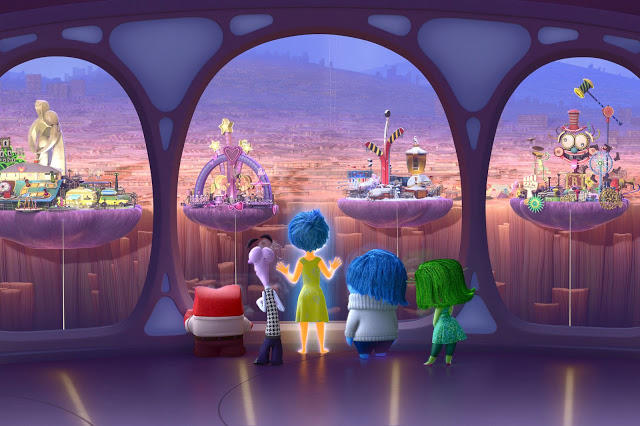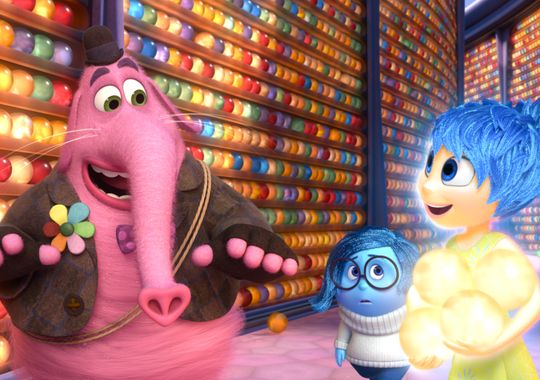At one point in Inside Out, the two main characters walk under a lettered archway that reads, “Imagination Land.” It’s a fitting marker, given that this movie is the latest (and nearly the greatest) offering from Pixar, that cinematic factory of innovation and ingenuity that has been delighting audiences for two decades with its inimitable blend of vibrant animation and smart storytelling. Also fitting is that the protagonists are named Sadness and Joy, as these are the two primary emotional responses that Inside Out deftly, generously evokes. You will undoubtedly experience pangs of sadness in watching this poignant portrayal of a child in crisis, struggling valiantly to process her swirling feelings of confusion, alienation, and loss. As for joy? That comes from everything else.
The ostensible hero of Inside Out is Riley (voiced by Kaitlyn Dias), a plucky, relatively normal 11-year-old whom we first meet moving with her parents from the ice-covered lakes of Minnesota to the bustling cityscape of San Francisco. Yet while Riley is the film’s chief human character, she is not its focal point. Rather, Inside Out takes us inside Riley’s brain to explore the workings of her emotions, which we discover are literal beings themselves, with their own bodies, minds, and temperaments. They include Fear (Bill Hader), a jumpy lavender fellow with a bowtie and a prominent proboscis; Disgust (Mindy Kaling), a greenish girl with wavy hair and perpetually rolling eyes; and Anger (Lewis Black, naturally), a squat and fiery hothead who regularly bursts into flame and whose color you can probably guess. Rounding out this fantastic five are, of course, Sadness and Joy; Sadness (The Office‘s Phyllis Smith, perfectly cast) is a rotund blue figure who wears oversized spectacles and shuffles her feet morosely, while Joy (Amy Poehler, ibid) is the yellow-skinned, cobalt-haired pixie who serves as the group’s perky, quietly flawed leader. These five personifications of feeling—exposed nerve endings made real—operate in concert (and occasionally in conflict), huddling over a gadget-laden control panel and helping to shape Riley’s experiences, her emotional reactions, and, really, her entire life.
As far as Pixar premises go, Inside Out‘s is among the studio’s most inspired. The recursive notion that our emotions are themselves people, grappling with their own challenges and processing their own feelings, practically throbs with opportunities for humor and wit, and Inside Out has tremendous fun just visualizing and verbalizing each character’s reaction to mundane events. (For example, here’s Disgust, encouraging Riley to reject a spoonful of broccoli during her toddler years: “That is not brightly colored or shaped like a dinosaur.”) The movie’s slyest, most uproarious conceit—which it wisely avoids leaning on too heavily—is its reveal that Riley’s quintet of color-coded anthropomorphized emotions is not unique to her. Rather, we discover that every person is governed by her own unique alchemy of these five interrelated impulses. This leads to the movie’s best, most hilarious, and sneakily insightful scene: a family dinner in which Riley’s own parents, gently probing about their daughter’s first day at school, are shown to be experiencing the same tumult of interlocking emotions as Riley. (The film also leverages this idea during its closing credits, which double the studio’s most crowd-pleasing tag since the blooper reel from A Bug’s Life.) Inside Out could have easily coasted on the sheer power of its concept, and it still would have been a blast.
But it is much more than that. This movie, which was directed by Pete Docter (his previous film for Pixar was the similarly inventive Up), is a thoughtful and deeply affecting study of humanity: how we think, how we act, and, most crucially, how we’re formed. Inside Out posits that our individual identities stem not just from genetics, but from the gradual accretion of memories. We experience an event, that experience molds our personality, and we continuously draw on our past memories of it when processing future experiences. Our memories, in circular fashion, become our selves.
That may sound pretentious, but remember that Inside Out is a product of Pixar; it smuggles its thought-provoking ideas inside shiny, brightly colored packages. Visually speaking, the movie is a marvel, not just for its predictably gorgeous and fluid animation, but for the way it combines brainy concepts with clever, streamlined art direction. It envisions Riley’s mind as a highly intricate sort of postal network, where actual memories are encapsulated within colored spheres—the pigment corresponds with the particular emotion responsible for the memory—then shuttled off to different parts of her subconscious. The most critical of these pulsating orbs are the so-called “core” memories: snapshots of seminal moments in Riley’s life that intermingle to create her “islands of personality”, five happily eccentric-looking locales that, as Joy puts it, “are what make Riley, Riley.” (There is even one island for hockey; remember, Riley hails from Minnesota.) Every detail of this memory palace has been painstakingly considered, but the animation is also highly functional, readily mapping the geography of this fascinating, brilliantly conceived inner world. That level of subtlety extends to the movie’s tremendous work with facial expressions, particularly Riley’s. She may simply be the vessel within which the film’s main characters reside, but in charting the contours of her countenance—the widening of her eyes, the narrowing of her mouth, the arch of her eyebrows—Inside Out silently reinforces the presence of the emotions that consistently buffet her. It allows you to see her feelings figuratively as well as literally.
And those feelings get put through the wringer. Though Inside Out is effortlessly charming even when little is happening, its plot kicks into gear when, to Joy’s dismay, Sadness inadvertently fumbles with Riley’s core memories. They get sucked out of their resting places and dumped—along with Sadness and Joy themselves—into the vastness of Riley’s subconscious. In addition to leaving headquarters in chaos—without Joy’s calming influence, Fear, Disgust, and Anger prove to be rash actors—this means that Riley suddenly has no core memories to draw on. Inside Out could have explored this development in any number of ways (I was half-expecting Riley to be stricken with sudden amnesia), but what follows is daring, exciting, and—when you stop to think about it—profoundly frightening. One by one, Riley’s five islands begin to crumble into dust, and each time, a central component of her very identity perishes. The horrific implication is that, robbed of her memories, Riley will soon be bereft of a personality, and a soul.
What follows is a fairly typical quest narrative—Sadness and Joy must gather the core memories and return to headquarters with all haste—though nothing in this movie could be described as typical. Certainly not Bing Bong (Richard Kind), a vestige of Riley’s childhood imagination who describes himself as a hybrid of elephant, cat, and dolphin (oh, and cotton candy). He is the childish id to Joy’s grown-up ego, and if his presence occasionally feels like a concession to the children in the audience, his warmth and sweetness are no less genuine. He is also emblematic of the movie’s astute grasp of the subconscious, which it represents in terms that are somehow chaotically cluttered and imperceptibly structured. Inside Out treats us to a veritable feast of playful, buoyant ideas: a literal train of thought, a rocket powered by song, a room of abstraction that renders its subjects in two dimensions, a cast of dutiful actors who read lines off cue cards to transmit weirdly distorted dreams straight into Riley’s head. Yet everything makes a certain degree of sense, allowing us to surrender to the film’s dreamlike logic without becoming overwhelmed by it.
As dazzling and ingenious as Inside Out may be—did I mention it slips in a hysterical Chinatown reference? What about its great runner involving a commercial jingle that perpetually gets stuck in your head?—its quiet, touching heart is the relationship between Joy and Sadness. Joy may be a novel creation—she is the literal manifestation of an emotion, after all—but you’ve actually met her before: She was the girl in your social studies class who took ownership of your group project to make sure you all got A’s, or the woman in your office who rewrote your proposal for the good of the company. She is, in other words, a highly talented, slightly exasperating micromanager, and her persistent frustration with Sadness is both understandable and infuriating. It is a dynamic that inverts the burgeoning friendship between Marlin and Dory in Finding Nemo, in which a narcissist slowly comes to recognize the worth of the strange, invaluable companion soldiering on beside him. Joy initially regards Sadness with a mixture of sympathy and irritation, but as she toils to save Riley’s core memories (and Riley herself), something gradually dawns on her: Without sadness, there can be no joy.
Inside Out has plenty of both. But it is no mere didactic sermon about the importance of friendship and acceptance. It is instead a breathtaking, powerful story of adventure and self-discovery, and it is as thrilling as it is stimulating. (It is gratifying to watch a big-budget animated movie that does not pander to its audience via loud, senseless action sequences.) It is enlivened with wry humor, splendorous beauty, and real emotion in every sense. Sadness is a pivotal character in Inside Out, and she provides the key to unlocking its hidden depths. But make no mistake: This movie is all about joy.
Jeremy Beck is the editor-in-chief of MovieManifesto. He watches more movies and television than he probably should.





So beautifully written! As a Pixar kid, Toy Story came out when I was a child, I love seeing these! Where does this rank on the Pixar list?
Thanks Allison! I'd probably rank it fourth, between Toy Story and The Incredibles. But that might change once I see it again. It's a great movie regardless. Hope you enjoy it.